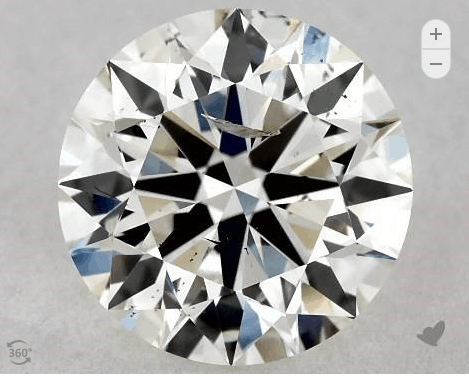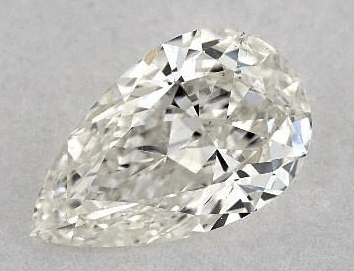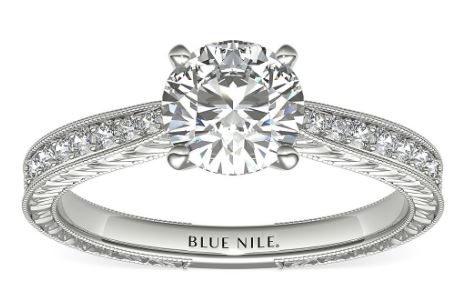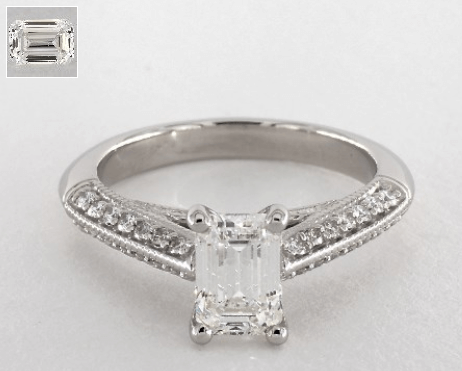An Expert Guide to I1 Clarity Diamonds
What Does an I1 Diamond Clarity Grade Mean?
What Does an I1 Diamond Clarity Grade Mean?
I1 diamonds are on the lower end of the clarity scale, with visible inclusions that can affect the diamond’s brilliance and fire. While they are more affordable, we generally advise against I1 diamonds for engagement rings due to their impact on the diamond’s beauty. However, there are exceptions where inclusions can be covered or are less noticeable. Prices for a 1 carat I1 diamond can range from approximately $2,100 to $3,500, but remember, the beauty and brilliance of the diamond could be compromised when there are readily visible inclusions.
When choosing an I1 diamond carefully examine the diamond certificate clarity plot to understand the types and locations of the inclusions. Look for inclusions along the edges that can be easily covered by the ring setting or prongs. Inclusions that are spread out can appear less visible.

In general, we advise against I1 diamonds, because inclusions at this level impact the brilliance and fire of the diamond. Large imperfections or a large number of imperfections obstruct light as it travels through the diamond, making it dull like you can see in this underwhelming diamond from James Allen. Obvious imperfections also detract from the beauty of the diamond, because your eye is drawn to the blemish.
But there are definitely some exceptions to that rule. For example, you can cover most of the inclusion on this diamond from James Allen with a prong and the diamond should look eye-clean and stunning. It ends up being a phenomenal deal for a one carat diamond.
Instead, we recommend going for VS2 clarity or SI1 clarity, because you can get an eye-clean diamond but pay far less than you would for VVS or FL clarity. You’ll still save your budget and can spend more on the aspect that most greatly impacts the overall beauty: diamond’s cut.
Learn more about I1 diamonds, why you should avoid them, and which grades on the diamond clarity chart you should choose instead.
Why you should trust us
What is an I1 diamond clarity?
What to watch out for with an I1 clarity diamond
I1 diamonds on the diamond clarity scale
Are I1 diamonds a good quality clarity grade?
Are I1 clarity diamonds eye clean?
Should I buy an I1 clarity diamonds?
How much is an I1 diamond worth?
FAQs
An I1 diamond is included to the 1st degree—meaning it has noticeable inclusions under a standard jeweler’s loupe at 10X magnification. I1 inclusions are also almost always visible to the naked eye, making them not eye-clean diamonds. According to the GIA laboratory, “Evaluating diamond clarity involves determining the number, size, relief, nature, and position of these characteristics, as well as how these affect the overall appearance of the stone”.
For step cut diamonds in particular—asscher, emerald cuts and baguettes—the imperfections in I1 diamonds are so obvious that they’re rarely produced. Diamond shapes like the oval cut and cushion cut hide inclusions well, so occasionally you can find a decent I1 diamond, but it’s still probably not eye-clean. You’d have to look through hundreds of diamonds to find an eye-clean I1. If the inclusions are spread out across the diamond, they can be less noticeable or the ring setting may cover them.
Besides impacting the diamond’s beauty, larger inclusions can lead to a less than durable diamond. It runs the risk of chipping easier, because the stone’s composition isn’t as sturdy.
To review I1 diamonds—or any diamond for that matter—you need magnified photos offered by a high-quality vendor like James Allen. Still, it can be difficult to determine if a diamond is eye-clean. You can ask an expert to help you review the diamond.
Even though I1 diamonds have visible inclusions, some jewelers might try to get you to buy one. Here are three selling tricks to watch for.
From our decades of experience, we know that an I1 diamond won’t be eye-clean unless it’s under 0.5 carat. Any larger diamond won’t be eye-clean at an I1 grade, because the larger the stone, the easier it is to see imperfections. There might be a few exceptions to this, but they are hard to find.
A clarity plot is a map of all the blemishes and inclusions in a diamond. Because an I1 grade means the diamond is included, it’s a red flag if the clarity plot doesn’t show any imperfections. You can’t trust the certificate or the jeweler or look for the reason (e.g. comments like “Clarity based on clouds that aren’t shown”).
While we know clarity isn’t the most important aspect of a diamond—cut quality is—it still impacts a diamond’s beauty somewhat. A glaring blemish is an eyesore. It takes away from the beauty of the diamond. Large imperfections also impede light from traveling through the diamond, making it a duller stone. If a jeweler tries to convince you to buy a diamond with a noticeable inclusion, it’s time to look for a different jeweler.
You’ll also want to watch for jewelers that offer diamonds with SI3 clarity. This is a red flag because the SI3 grade is used by lab entities that aren’t reliable. You’ll end up with a diamond that lacks beauty and value.

To get the most out of your budget, opt for an eye-clean diamond but don’t pay more than you need to. Typically, that’s a VS2 or SI1 diamond.
Before buying a diamond, ensure that it comes with a lab certificate. We only recommend a GIA certificate because it’s the most consistent and reliable.
The GIA grades diamond clarity from best to worst:
As a diamond forms over billions of years, its structure picks up small imperfections along the way. A diamond’s clarity grade depends on the size, type, and location of its inclusions and blemishes. Diamonds with bigger inclusions, more inclusions, and darker inclusions will have a lower grade. Professional gemologists look at each diamond under magnification to determine the grading.
I1 diamonds are not a good quality for the center stones of engagement rings. You’ll be able to see imperfections that impact both the beauty and brilliance of the stone. As an example, this I1 round diamond halo ring from James Allen shows a large inclusion in the upper right corner of the diamond’s table. Even though the stone is well-cut and is graded with an H color, it’s not a smart buy, because the large imperfection is so noticeable.

For smaller stones, like the ones that line a pavé band, or are featured as side stones, I1 diamonds are acceptable. In fact, there’s no reason to get a higher clarity grade for diamonds under 0.5 carat, because you won’t be able to see the imperfections anyway. Choosing I1 or even I2 clarity for the small stones in a pavé ring or a tennis bracelet is a wise choice and will save some of your budget for other qualities.
While this article addresses the technical grading and value of I1 clarity diamonds, that is not what we recommend focusing on when purchasing a diamond. In our opinion, a consumer’s goal should be to find the cheapest (in regards to clarity; other factors matter as well) “eye-clean” diamond you can find. We use “eye-clean” to describe diamonds that may have inclusions if you look at them with a magnifying glass (or microscope or loupe), but the typical person can’t see the inclusion with their naked eye.
We have recently developed Ringo, a patented artificial intelligence model, that can examine videos of diamonds and determine if they are eye-clean. Ringo will also filter for other parameters like making sure the diamond is well-cut, doesn’t have fluorescence issues and will match the style setting you choose.
If you want to select a diamond specifically for your personal needs (budget, shape and setting style), check it out here.
You shouldn’t buy an I1 diamond for the center stone in an engagement ring. Instead, look for an eye-clean VS2, SI1, or SI2 diamond. In most cases, you’ll get an eye-clean diamond in these grades and won’t pay as much as you would for higher grades, such as VVS1 and VVS2 clarity.
The best clarity grade depends on your diamond shape and carat weight. Follow our expert recommendations to get the most value.
Round cut and princess cut: Opt for a VS2 or SI1 clarity grade for an eye-clean stone. Sometimes an SI2 won’t have visible inclusions either. For large diamonds, a VS1 or VS2 gives you an eye-clean stone at the lowest price.
Oval cut, cushion cut, radiant cut, marquise and pear shaped: Inclusions are harder to see in these shapes, so an SI1 or SI2 is usually still eye-clean.

Emerald cut, asscher cut and baguette: It’s easier to see imperfections in step cut diamonds. In general, a VS2 in these shapes gives you the best value.
Heart shaped diamonds: A VS2 or SI1 is usually eye-clean, because heart shape diamonds hide inclusions better than round cuts, but not as well as shapes like the cushion cut and marquise.
A 1 carat well-cut round diamond with G-I color and I1 clarity can cost anywhere from approximately $2,100 to $3,500. Not every diamond vendor sells I1 diamonds, though, because the quality is so low.
Even though the price of I1 diamonds is lower than diamonds with a higher clarity grade, we don’t suggest buying them. It’s better to pay a little more to get an eye-clean stone.
While certain jewelers and other diamond educators might try to convince you that an I1 diamond gives you the best value, the truth is: you should find an eye-clean stone. It’s not worth paying slightly less for a diamond that will be dull and not-so-beautiful. Instead, opt for a slightly higher clarity grade to get an eye-clean stone. You’ll still save hundreds or thousands over a high-clarity diamond.
In most cases, an I1 or lower clarity grade will affect a diamond’s fire and brilliance (which many refer to as its “sparkle”). This is because the size and prominence of inclusions in these diamonds are significant enough to obstruct light from passing through the diamond.
The lowest quality diamonds, in terms of clarity, are I3 (Included 3) diamonds. There can still be a big difference in quality between diamonds graded I3, but this is the lowest that the GIA grading scale goes.
I1 diamonds are very low on the diamond clarity grading scale, and in most cases are below the acceptable threshold when assessing clarity.
A nice one carat round diamond that is I1 clarity costs about $2,900. The diamond price can vary a bit based on which shape you select, what color grade you go with, and whether it’s well cut or not.
For help in reviewing diamonds for clarity, send our experts a note.




Before you buy a diamond, get personal buying advice from industry veterans. We'll help you get the best diamond for the money.
DISCLAIMER: We don't use your email for marketing. Period.
A diamonds’ price is determined primarily by the 4 Cs of the diamond. On the wholesale level, diamond prices are first based on a diamond shape and
Buying an engagement ring is often one of the first major purchases in a person's life. The process can be fraught with tension as there are so m
A wide range of 1 carat diamonds exist both in online markets and local diamond jewelry stores. Not only are there significant differences in beauty
Please enter your email address to receive your 25% off coupon code:
Here is your coupon code: GFDSF3GF